


|
 |
|
|
#1 |
|
Registered Member
Join Date: Jun 2003
Location: Colorado Springs
Posts: 2,707
|
How to catch a Mantis in your reef
So you have a mantis in your reef.
Catching these elusive critters isn't the easiest thing because they aren't dumb. It will take cunning and maybe a little luck. The most common method is to use a "bottle trap". Take a water bottle, the larger the better (use a water bottle because some of the chemicals in soda pop can permeate the plastic of the bottle) and cut the top off of the bottle where the sides are straight up and down. Take the cut off top, remove the cap, invert it and shove it back into the bottom so you have a funnel leading into the bottle with the cap end inside the bottom. Then remove as much of your CUC as you can and move them to a place that the mantis can't get to, such as your fuge. You want to make the trap as alluring as possible, and the mantis as hungry as possible. Bait the trap with a crab, or silverside as snails may escape (you may need to do this before putting your top into the bottom of your trap). Set the trap on its side near where you think your mantis has made its home, and leave it. I would also get it as low into your sand bed as possible to make it easier for your mantis to find its way in. Check the trap fairly regularly but keep in mind that your foe has incredible eyesight so you don't actually want to just sit there watching because you are probably being watched yourself. Once you have trapped your thief move it someplace that it can't escape and return your CUC to the tank. IF your mantis escapes the trap things will become more complicated. Remember where I said they aren't dumb? If your interloper makes an escape, it now knows the trick to escaping the bottle trap and unless you are lucky and find the mantis while it's in the bottle it will just go, remove the bait and go back home. That is why I said the bigger the bottle the better, with a bigger bottle the mantis is less likely to find its way back out of the bottle. Should you find yourself in this position then you may be forced to find the rock it is living in and remove the rock to get the mantis. A good indication you have found the Mantis Lair, is the accumulation of broken snail shells and crab parts. Once you have found your mantis' home and removed the rock. Probably the most effective way to get it to vacate the rock is to pour soda water into the hole it is living in. Many people will advocate hypersaline water dips and fresh water dips to force the critter out, but many mantis are adapted to live in rather hostile environments where they are subjected to low O2 levels, rapidly rising salinity, or even fresh water from rain; so they can stand these dips for quite some time. No mantis is evolved to stand soda water. Not to mention mantis can be rather stubborn bugs who don't easily vacate their homes. Once you have trapped your problem mantis post a thread in the mantis forum that you have caught a mantis and would like to get rid of it. The regular posters will most likely be more than happy to pay for the shipping. Good luck and happy hunting.
__________________
What have you done with my Illudium Q-36 Explosive Space Modulator Earthling? The memories of a man in his old age, Are the deeds of a man in his prime. Pink Floyd Last edited by Thurge; 09/22/2009 at 02:42 PM. |
|
|

|
|
|
#2 |
|
The Hardy Mongolian Pony
Join Date: Nov 2008
Location: Dallas, Texas
Posts: 1,372
|
Thurge you beat me to it. We've needed this thread for so long, hopefully it will be stickied.
So how do you know if you have a stomatopod in your reef tank? It should be noted that you must know there is a mantis before attempting removal. If there isn’t a stomatopod in your tank, well, you’re just wasting your time. The familiar claim is “I keep hearing a clicking noise at night coming from my tank.” God knows, this could be anything. I’ve heard my tank “click” when my stomatopods weren’t even striking anything. I could see them out in the open just watching me and hear a click noise. A click can be almost anything, a thermometer, a hermit crab’s shell hitting glass, even some fish make a noise that is similar to a mantis strike. The point is just because you hear a click doesn’t mean you have a mantis shrimp in your tank. The tell-tale sign is broken shells. If you see your hermit or snail shells bashed in and pieces all over the place it is safe to say you have a mantis. Also if you see one (and this is usually rare), but is the most positive proof. Usually you will only see the eyes watching you from a hole. To get an idea of what you are looking for, consult pictures of these guys and get to know they’re anatomy (hint, Roy’s List). The more you learn about them, the better your chances of a successful hunt. When do they come out in the open? When they are hungry, or sometimes just curious. They are very curious creatures and therein lies they’re vulnerability. Stomatopods only need to eat about once/twice a week to survive and they can go even longer (a month) during a molt without eating. That being said, if you are attempting the bottle trap or are trying to lure it out using food, don’t let any meaty food particles hit the substrate. Any scraps can be foraged and taken back to the burrow to sustain the animal. When searching for food, they will make slow movements around rocks and zip back into their burrow. If nothing is found, they will do this several times before staying inside the burrow. Like Thurge said, if you know you have a mantis, remove the clean-up crew. Also any hard or soft bodied crustaceans are on the menu as well. Fish, not so much, slow bottom dwelling fish are most vulnerable. Many species will seal-up their burrow at night using small rubble and sand. However, to be sure, consult the species guide of Roy’s List or http://www.mantisshrimps.co.uk/care.php to get a handle on what species you may be dealing with. A common hitch-hiker is the mantis Neogonodactylus wennerae. Small rock dwelling species like this one are often found in reef tanks as well. In short, match where your live rock came from with the species to learn of the activity of the stomatopod. Their time of activity can lead to a better capture and a proper plan. So how do I get this killing machine sent from Hell out of my tank?!? First off, while having a mantis shrimp in one’s reef tank may be a little unnerving; these animals have been given an incorrect reputation within the reefing community. A common hitch-hiking mantis will NOT break the glass. There are only two species that do this and they must get large in order to produce the necessary force to break glass. These two species are Odontodactylus scyllarus and Gonodactylus chiragra . Contrary to popular belief, they do not kill on sight. The majority of your fish will be safe, the clean-up crew is where the damage is done and that is if they need to feed. Can a mantis catch a fish? Yes, but look at it from the standpoint of the mantis, why waste energy catching a fish when you can just grab a snail? Mantis shrimp also do not eat corals, nor will they damage them. The only exception is if the coral is not anchored down to a rock. The mantis will usually move the coral to block its burrow entrance, only it will be the wrong side up. So your corals are safe. At this point you must decide if it is really worth all the effort you are about to go through to get this animal out. Sometimes it is better to just leave the mantis in the tank. As crazy as it sounds, if you keep it fed and full , it won’t kill for food. “A fat mantis is a happy mantis”. At this point if you are still convinced that a stomatopod in your tank is your worst nightmare read on. Biological Control: Doesn’t anything eat these creatures? Yes, but most of the time they are more destructive than the mantis in a reef tank. Puffers, Triggers, Cephalopods, Lionfish, Moray eels, all have the ability to solve your mantis problems. However, just because a trigger is in the tank doesn’t mean the mantis will be eaten; meanwhile your corals are being crushed by the trigger. Basically, biological control is a bad plan because all of the above animals can do more damage than the mantis. Chemical Control: What about Copper? Even small amounts of copper can kill a stomatopod. Unfortunately, Cu will also kill most of your inverts and hence isn’t a great option. If you have a fish only tank, well you’re in luck. Getting your hands wet: Ok ok what do I gotta do? The Bottle Trap http://www.mantisshrimps.co.uk/articles/removal.php Thanks to Justinl for this article. I would like to add that there are additional ways to construct a device to catch these guys. It’s truly amazing what you can do with plastic screens and zip ties. I’ve seen little chambers constructed out of just these two materials. One way is to make the trap in the shape of a heart with the opening located in the top, between the two curves. The opening should continue down to the point of the heart with just enough room for a fish to swim through. You can also put more barriers within the two halves of the heart. Simply put, the more turns and the more complicated the trap is, the better your chances of catching the mantis. In all honesty I have yet to hear of the bottle trap working. The most successful ways of catching these animals in your reef is the most direct. Get creative, the mantis sure is. Rock Location and Removal The best way to get rid of a mantis shrimp is to find the rock it is using as a home. Simple right? Yeah, no. The best way to tell what rock the animal is in is to watch in physically enter/leave the hole. They can burrow inside rock and underneath so the mantis can be underneath rock work as well. Another way to tell is to look for a sealed hole. You will see crushed snail shells and sand blocking a hole. If you see that it is safe to assume the mantis is using that rock as a home, remove it and place it in a bucket of saltwater for now. The following is a post from Dr. Roy Caldwell on the removal of a stomatopod from a rock cavity at this stage. “N. bredini can survive in fresh water for several minute and often do not bail out when hit with it. These are animals that live in cavities on exposed reef flats. They encounter dessication, high temperatures and fresh water (rainstorms at low tide). In short they are extremely tolerant of nasty conditions and other organisms in your LR are likely to be damaged before the stomatopod comes out of its cavity. I have seen N. bredini survive over a day in a piece of LR left to dry on a counter. When I have to remove an animal from a cavity, try to be another stomatopod and poke at it with a probe for several minutes until the animal gives up and flees. I usually do this with the LR in the air for a few minutes, then return it to a bucket of water with more poking. With a blunt probe and a little care, you can avoid damaging the animal. I also sometimes use a clove oil solution to anesthetize them and then remove them with forceps. (This works well in the field. For example, we perfected the technique to remove a species of stomatopod that was found in cavities in large barrel sponges found at 50-60 m. With very little bottom time, we could usually find and remove three or four on a dive.) The one dip that seems to work to some extent is sparkling soda water. The carbonic acid may be sufficiently irritating to their soft tissues to drive them out. I've tried it a few times (I filled the cavity with selzer, let it stand for a minute or two and place the cavity back into sea water.” - Dr. Roy Caldwell If these techniques do not work, hammer time. Get a hammer and bash that rock in half. If you wish to safe the mantis, and please do, you can leave the mantis rock in a small container and try to entice it out with food. If it never comes out, just leave the rock in there until it does and remove the rock afterward. What if I cannot find the rock? Guess what, it’s time to roll up those sleeves and do what I do when moving mine. Note: This involves tearing down all the rockwork and moving it, so if this is not possible for you, well, tough luck, keep trying the bottle trap. Or you can learn to live with the mantis (it’s really not that bad). First you need to start lifting up and shaking the hell out of every rock you have, after shaking it, put it to one side of the tank. There is no guarantee that shaking the rock will remove the mantis but it always works for me. Usually the mantis will be in between the rock and the substrate so simply moving it will make it shoot out. Repeat this until you find the mantis and use a big net to corner it against the glass. Once the mantis is out in the open, quickly move all the rocks to one side and keep an eye on the mantis. DO NOT let it get to the side of the rocks. The goal is to move all the rocks to one side of the tank and keep the mantis on the other side. In cornering the mantis, slowly move the net toward it and try to distract it with another object (another net/feeding stick). Get the mantis in between the net and the glass and press the net up against the glass. This point is critical because when you start moving the net close it will most likely dart to one side or the other (emphasis on big net). And obviously make sure it is a fine threaded net, no big holes. They are very good swimmers and extremely quick when startled. Take your time. Once the mantis is up against the net and glass, just slide the net up, keeping it pressed up against the glass, until you get to the surface. Quickly lift the mantis out and place it in a container of saltwater. There you have it, you have captured a stomatopod. Now you can sell it to us! Money for your nightmare! I would like give credit to Dr. Roy Caldwell, Justinl, Trappedmetal, Thurge, and anyone else who posted about not being able to get a mantis out. Much of the information from this post came from this forum and my memory of past experiences/posts. Happy Hunting! Last edited by Koshmar; 09/23/2009 at 11:54 AM. |
|
|

|
|
|
#3 |
|
Registered Member
Join Date: Jan 2009
Location: Odessa/TX
Posts: 117
|
thanks guys it is a cool looking mantis but you all know as well as i do the cost of snale crabs light foots and emerals add up if i happen to catch this guy he will be free to whom ever wants to pay shipping or pick him up
__________________
REDNECK Current Tank Info: 200 GAL REEF |
|
|

|
|
|
#4 |
|
Registered Member
Join Date: Jun 2003
Location: Colorado Springs
Posts: 2,707
|
I am definately interested in this mantis.
__________________
What have you done with my Illudium Q-36 Explosive Space Modulator Earthling? The memories of a man in his old age, Are the deeds of a man in his prime. Pink Floyd |
|
|

|
|
|
#5 |
|
Registered Member
Join Date: Mar 2008
Location: Kennett Sq, PA
Posts: 496
|
bump for sticky?
|
|
|

|
|
|
#6 |
|
Stomatoholic
Join Date: Jan 2009
Location: Fort Myers, Florida
Posts: 1,101
|
+1 on sticky!
__________________
Stomatopod's are my weakness. i want to own them all like a little kid wants to own all the damn pokemon Current Tank Info: 29g FOWLR, 40b peacock tank (Khaleesi, female), 10g Male G. Graphurus (Boh, male) tank. |
|
|

|
|
|
#7 |
|
Registered Member
Join Date: Mar 2008
Location: Kennett Sq, PA
Posts: 496
|
Wow great info

|
|
|

|
|
|
#8 |
|
The Hardy Mongolian Pony
Join Date: Nov 2008
Location: Dallas, Texas
Posts: 1,372
|
One of the things I've been working on lately has been a new mantis trap to help out those who seek the capture of this allusive animal from their tank. I still have a few other sketches and ideas which I may work on later but at the moment I have finished and tested my current creation. As most of you know, the bottle trap, while being good at catching crabs and certain fish, has its short commings when used to capture a mantis. It doesn't work all the time and usually catches the clean up crew more often than not. Also you must be there to pull the trap up, you can't just let it sit for too long or the mantis will eventually find its way out. Suprisingly there is another simple yet effective trap which you can create out of common items which you probably have already. It utilizes two things that are pretty certain in this hobby, gravity and the stomatopod appeitite. It's basically a box with a falling gate that traps a mantis shrimp in a plastic cage. All you have to do is bait the trap, set the gate and let the stomatopod do the rest. No watching required, the animal won't escape while you're away. So let's get started:
Materials 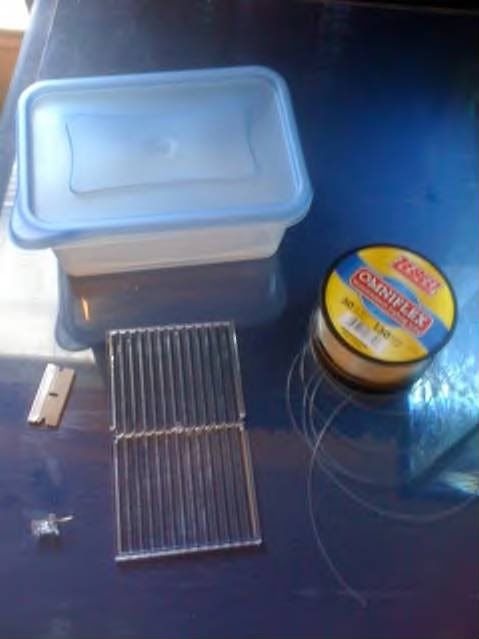 1. Razor blade (Be careful kids! Get your parent's permission before using sharp instruments. Seriously, I've almost cut myself several times making these things) 2. Fishing line 3. A simple tupperware container (I've found longer is better but mainly make sure the container will fit in your tank.) 4. A thumb-tac 5. Breeder box top (Ok so you might not have this yet but I found the top of a breeder box lying around and found it to work perfectly. If you don't have one, you can craft your own gate. A good idea would be to get some thick plastic, cut slits in it, and weigh it down with something at the top (use that fishing line to wrap a few rubble pieces around the top). Also make sure that gate is slightly less wide than your tupperware box width, you'll see why soon). Making the trap 1. Take your tupperware top off and cut a hole/rectangle in a side with the smaller width using your razor. (Be careful! Razors are sharp!) 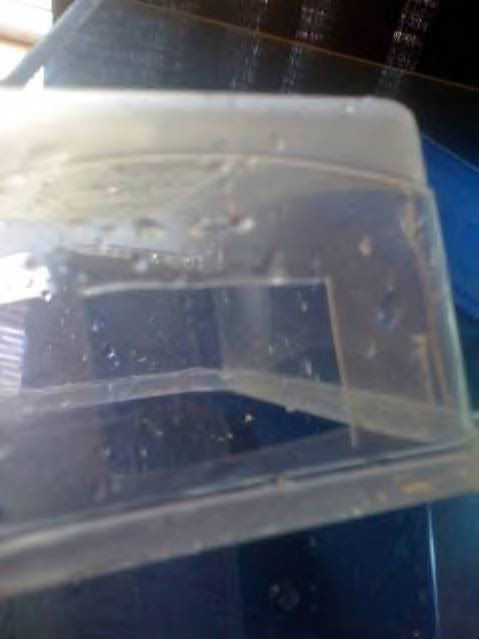 2. Cut a slit wide enough to let your gate fall through in the top. This is an important step because you want the slit to be wide enough to allow no friction to impede the falling of the gate but small enough to prevent the gate from wobbling. Luckly I solved that little wobble issue with another step later on but still be careful with the size.  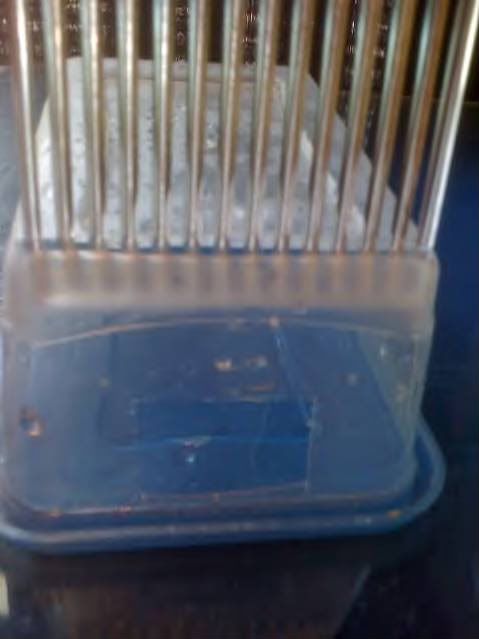 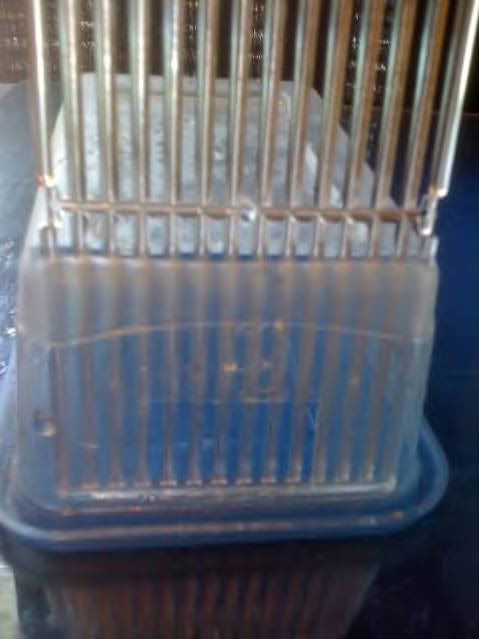 3. Punch to one hole on each side of your entry way using the thumb-tac but slightly elevated above the opening. Make sure these holes are equal in height as well. 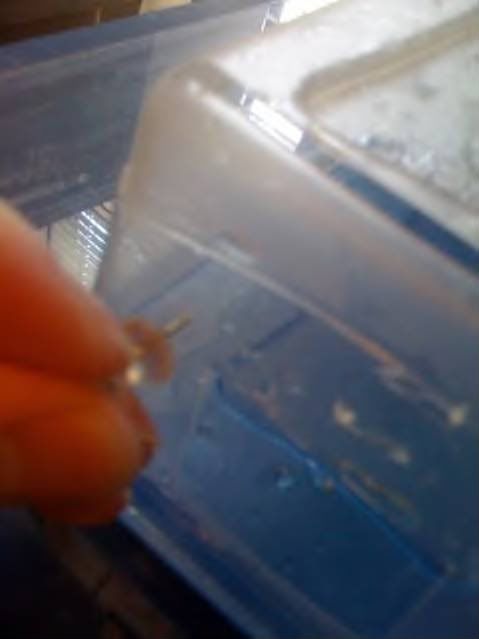 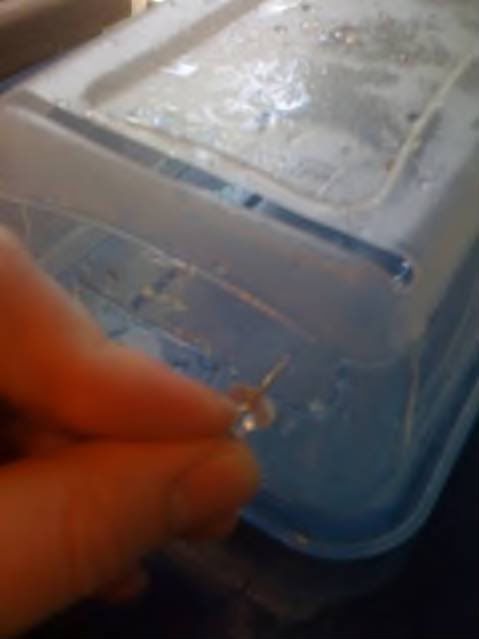 4. Cut a length of fishing line (longer is better at this point, about three times the length of the container should be enough). 5. Make a knot in the middle of the line.  6. Punch many holes in the top of the container. (This will help with the buoyancy issue, more on this later). 7. Cut two slits in the sides of the box behind where the gate will come down and cut some plastic pieces to fit into the slits. You can use a thin piece of plastic from another tupperware container or what you made your gate out of. Or pretty much anything that will fit through the slits. (See picture) 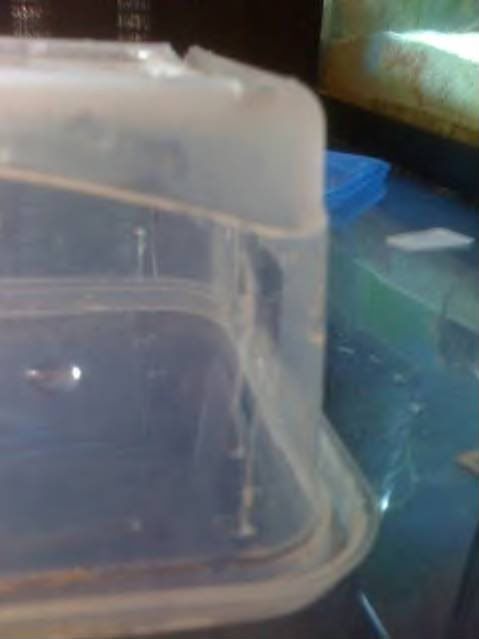 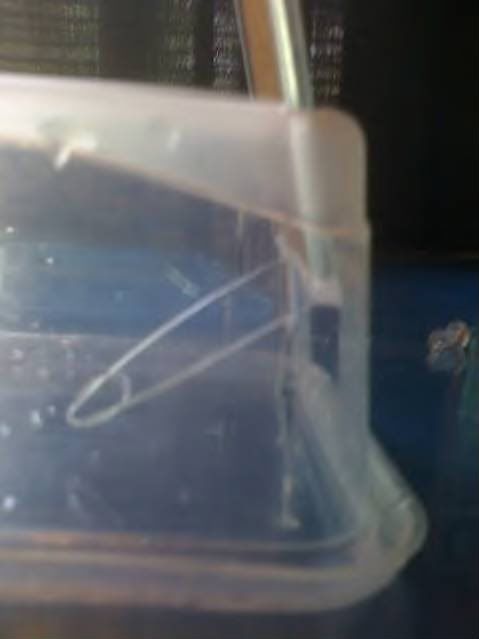 8. Time to set your trap! (You'll need a piece of meaty seafood for this part, krill worked wonderfully for me but just make sure you can tie that fish line around it) You know that knot you tied in the fishing line? Put the piece of meat in the knot and tie the meat to the line. The knot should still be in the middle. Now double knot it and make sure the meat is really secure but not so much that it's cut in half.
__________________
All Day I Dream About Stomatopods Last edited by Koshmar; 04/06/2010 at 05:51 PM. |
|
|

|
|
|
#9 |
|
The Hardy Mongolian Pony
Join Date: Nov 2008
Location: Dallas, Texas
Posts: 1,372
|
Con't.
9. Take the two ends of the fishing line and thread them through those two holes at the entryway you made with the thumb-tac. See the length of the line in the picture. Make sure the meat is roughly in the middle of the box and cut off the excess ends of the fishing line. 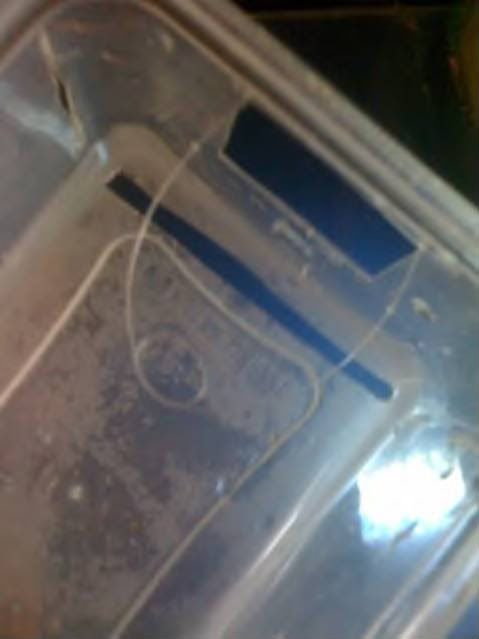 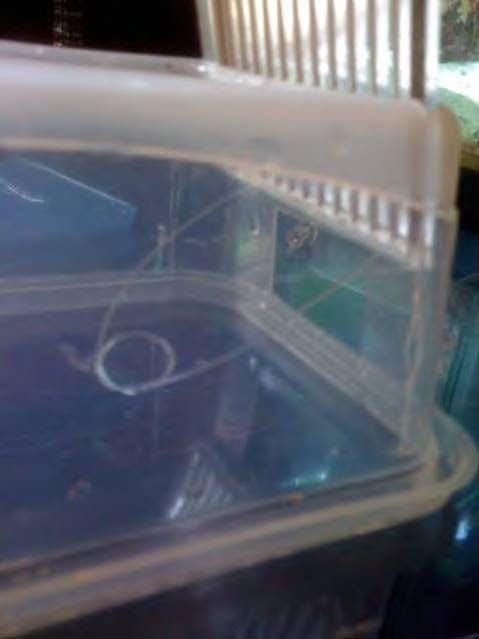 10. You may want to wash the trap off with water before this step. Put the top of the tupperware box on securely and push the trap down into your tank's bottom. Take a light rock and set it on top of the trap. 11. Put your gate into the slit at the top. Push the ends of the fishing line into the box until they almost come out the other side. Make sure the gate doesn't pull the lines out prematurely. (yeah I know interesting wording there right) (See pictures). 12. Just watch the trap for a minute and make sure it looks like the pictures before just walking off. Once everything looks right, you're good to go! So how do I know this works? 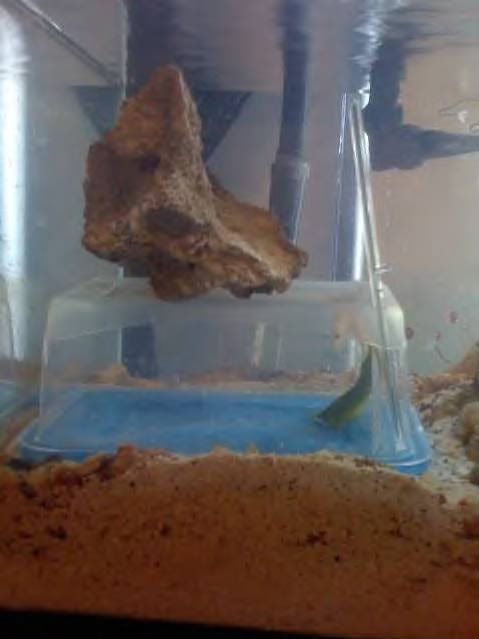 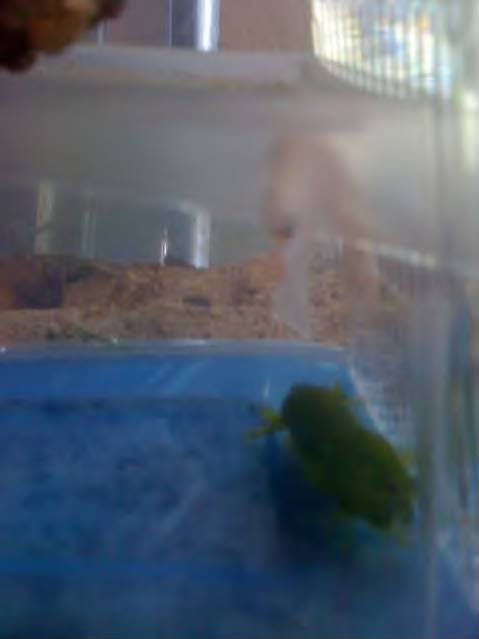 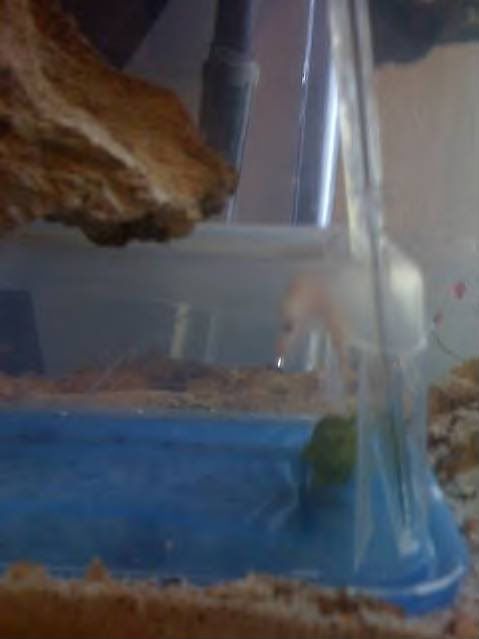 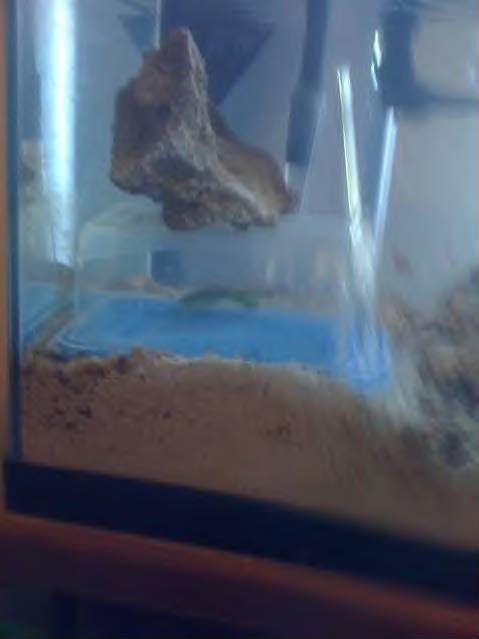 Don't worry she was released within a few minutes and she got that whole big krill for all her work. I must admit my first one didn't work so I had to keep revising it. I also encountered many problems and found solutions which will help you in creating your own trap. So here's a few tips: Buoyancy is a major problem with the gate mechanism. The gate must be light enough for the line to support its weight but heavy enough to actually fall. It looks fine and works great outside of a tank but when you put it in water you'll find a lot of things change. It's a simple case of "it worked great on paper". Make the proper corrections by adding weight using rock rubble or something of the nature tied to the top of the gate. Another issue is the trip system. One of two things can mess up; the mantis can, and I kid you not, untie the knot. Yes, that's right. It happened to me, which is why I strongly suggest double knoting the bait. They don't try to untie it first off, instead they rush at the bait which is another reason to keep the line short. If the line is kept short then the mantis will trigger the gate fall quickly. The other issue is the friction of the line against the hole edges. Try making the holes slightly larger than the diameter of the line, create an easy tripping mechanism but not so easy that the weight of the gate triggers itself. You can also fray the line at the tips somewhat to make angled ends. Also make sure the bait is roughly in the middle of the container or slightly further from the entrance. Do not put the bait at the very end because the line will not come out and trip the gate mechanism. Putting gravel at the bottom of the trap is also a good idea for buoyancy countering, though the rock works well. I also found out that mantis shrimp have a very difficult time with plastics and finding a way out of a CLEAR container. They don't always go for the entrance at first, nor do they immediately know they are trapped. Sometimes my N. wennerae would freak out even though the gate hadn't come down at all because she couldn't find a way out easily. She still came back though and was trapped. I made this trap right infront of both my mantis shrimp so even though they are intelligent, they aren't ridiculously intelligent like I was afraid of. The point is that they can still be trapped even if they watch you make the it. Currently I'm working on finding out their learning curve by reintroducing the trap during each feeding. I want to see how long it takes her before she figures out to avoid the trap even when there is food. A little experiment I guess you could say. I'll post those results someday along with how my large 3 1/2 inch G. chiragra (Chet) fares against the trap. Just to let you know the N. wennerae (little buddy Dallas) is aprox. 2 inches. I haven't tried making one for a peacock yet so we'll see about that later. Last thing: before you try the trap out I suggest posting some pics of your's for me to take a look at that way you don't scare the little guy before you can actually catch it. Feel free to PM me or post your comments or suggestions. I want to try and make this thing even better.
__________________
All Day I Dream About Stomatopods Last edited by Koshmar; 04/06/2010 at 05:43 PM. |
|
|

|
|
|
#10 |
|
Stomatoholic
Join Date: Jan 2009
Location: Fort Myers, Florida
Posts: 1,101
|
awesome koshmar this is really cool and the write up with the pictures make putting this together fool proof.
__________________
Stomatopod's are my weakness. i want to own them all like a little kid wants to own all the damn pokemon Current Tank Info: 29g FOWLR, 40b peacock tank (Khaleesi, female), 10g Male G. Graphurus (Boh, male) tank. |
|
|

|
|
|
#11 |
|
Mantis Shrimp Addict
Join Date: Aug 2005
Location: Southern California, formally Virginia
Posts: 809
|
Kudos!
__________________
ExtraordinaryMantisShrimp.BlogSpot.com 2014 Honda CrZ CEX Current Tank Info: Total System 255.64 gallons | Odontodactylus japonicus: 'Alice' - female, 6" from Sri Lanka (Deceased 2009-10.26.2010/9:24:29am) | Best things ever! Macintosh, Hybrids, Cephalopods & Stomatopods! |
|
|

|
|
|
#12 |
|
Registered Member
Join Date: Mar 2008
Location: Kennett Sq, PA
Posts: 496
|
Great trap idea!
|
|
|

|
|
|
#13 |
|
Registered Member
Join Date: Jul 2010
Location: illinois
Posts: 30
|
great trap ideas, I hope I never have to use them! now that i read this, i am sooo lucky mine was in a rock on top of my pile that i could grab out of the tank. these things are not only smart, but crazy resilient! i soaked the rock in fresh water for a good 10 minutes and nothing. i even held the rock out of water completely for 5-10 minutes and nothing. I finally boiled some water, took my coral-feeding syringe, and shot it repeadetly into his tunnel. he came flying out at lightning speed, scaring the crap out of me! he fell into a bowl of fresh water, flopping on his back and "dying." 15 minutes later, he came back to life and was swimming around in the fresh water! i tell you, these things are scary!
|
|
|

|
|
|
#14 |
|
Gallantly Forward
Join Date: Sep 2010
Location: Jacksonville, FL
Posts: 563
|
Congrats on removing him! Is it still alive and can you post a pic? I'm curious to see what it is myself. If you don't want it I'm sure someone here in the forums will be willing to pay S&H for a mantis.
|
|
|

|
|
|
#15 |
|
cats and large squashes
|
A handy tip if you're using the rock removal method: Hold a net under the rock as you lift it out. The crafty creature may flee the rock before you can get it out of the tank. At least mine did -- until I utilized the net on the third try. Good luck!

__________________
Marie So long, & thanks for all the fish! __________________________ Current Tank Info: Pairs: flame angels, cherub angels, Red Sea mimic blennies, yellow fin fairy wrasses, clowns, mandarins, blackcap basslets, shrimp gobies, damsels, dispar anthias, yellow clown gobies, threadfin cardinals --- Tanks: 100g reef, 2 x 30g refugiums |
|
|

|
|
|
#16 |
|
Registered Member
Join Date: Jun 2009
Location: Canada
Posts: 80
|
I think I have one in my tank! but I have not seen any threat to my snails, Hermit crab or fish. it is a very sneaky creature for sure. (if it is really a Mantis Shrimp or I may be wrong) Even my slow moving Mandarin Goby is fine! I will try to make some pictures or a video of the guy (I have to hire a Paparazzo!) hopefully you guys can ID the thing! Thanks for the great info on this issue though!
|
|
|

|
|
|
#17 | |
|
Mantis Shrimp Addict
Join Date: Aug 2005
Location: Southern California, formally Virginia
Posts: 809
|
Quote:
 Lets hope! Lets hope!
__________________
ExtraordinaryMantisShrimp.BlogSpot.com 2014 Honda CrZ CEX Current Tank Info: Total System 255.64 gallons | Odontodactylus japonicus: 'Alice' - female, 6" from Sri Lanka (Deceased 2009-10.26.2010/9:24:29am) | Best things ever! Macintosh, Hybrids, Cephalopods & Stomatopods! |
|
|
|

|
|
|
#18 |
|
Registered Member
Join Date: Jul 2011
Location: CT
Posts: 3
|
Wish I had come accross this forum earlier, I've caught two of these buggers and brought them back to the lfs which ended up becoming dinner for their bigger fish.
|
|
|

|
|
|
#19 |
|
Registered Member
Join Date: Mar 2011
Location: StL
Posts: 58
|
i think that i might have to use this idea for my mantis. Great help thx!!!
|
|
|

|
|
|
#20 |
|
Registered Member
Join Date: Oct 2011
Location: Pleasanton, CA
Posts: 2
|
All evidence points to hitchhiker mantis shrimp in my tank!
I have discarded turbo snail shells, a couple of crab legs strewn about, and other shell pieces all over but no sign of the mantis shrimp and it's lair. I hear the snapping sound and try sneaking up to perhaps see it but no luck. I have 2 clowns, a six line wrasse, and an algea blenny. Other fish have disappeared without a trace of their bodies. I've set traps and caught crabs but no mantis shrimp. I am not going to put anymore fish or turbo snails in the tank until I catch him. My tank is 95 gallon octogon, tall. I'm not sure what kind of mantis it is because I've yet to see it. I've had my tank 2 years almost. I'm going crazy. Is it possible to starve it out? It must have hitchhiked on but it is most definitely not the typical nice/mellow hitchhiker. What kind do you think it is?

|
|
|

|
|
|
#21 |
|
Registered Member
Join Date: Mar 2011
Location: Tennessee
Posts: 1,836
|
Well, from the smashed shells and popping noises, it's a smasher mantis. Other than that, I don't think it's possible to tell what kind of mantis it is.
You could try to starve him, then maybe he'd go for the food in the trap... but I'd think it would take a while for him to get hungry... He'll just feed off your CUC/hitch hikers. But it might be worth it to try to starve him. I use this little trick with my camera: Get the camera, stand however far away, then use the zoom... If you really want to see him, then you could try this.
__________________
The most intelligent people ask the most questions. |
|
|

|
|
|
#22 |
|
Registered Member
Join Date: Oct 2011
Location: Pleasanton, CA
Posts: 2
|
He doesn't seem to like to eat hermit crabs but he has taken down some hitchhiker crabs so starving him is working somewhat. I will use the camera idea. Great idea!
|
|
|

|
|
|
#23 |
|
Registered Member
Join Date: Mar 2011
Location: Tennessee
Posts: 1,836
|
I had a N. Wennerae ( a smasher) not like to eat hermits... he mainly went for snails.
Use a tripod or back of a chair or side of the wall or something when you do the zoom trick. When you are zoomed in real far, any tiny shakes will be major.
__________________
The most intelligent people ask the most questions. |
|
|

|
|
|
#24 |
|
Registered Member
Join Date: Nov 2010
Posts: 181
|
I also have a mantis. I've heard him and have lost many snails and blue legs. Have seen parts of them here and there. I bought a nice big cheap magnifying glass. When you are feeding preferably something meaty get that magnifying glass out and watch for him coming out to feed. I did this and found him.They are very cautious even when feeding so it takes a keen eye. Mine likes the bottom and burrowed under a rock. Upon closer review I saw there are two of them there, great! Also I have a nice pocket flashlight and using that with the magnifying glass after lights out is a great way to search the rock to find your mantis. I've tried a trap that I bought online that has a door that releases twice with no luck with a nice meaty shrimp in it . These bastards are smart. Good luck locating him. I have alot of rock and fear I may have more than two. My CUC is pretty much decimated. I do have some nice emerald crabs and they have not been eaten YET...
|
|
|

|
|
|
#25 |
|
Registered Member
Join Date: Jul 2011
Location: syracuse ny
Posts: 56
|
I have all the tell tale signs of a Mantis shrimp. disappearing fish, crabs, snails broken shells. the crunching sounds. tried traps finally out of frustration pulled all the rock out drained tank and scooped up all the sand. rock is in buckets and fish in another bucket thoroughly looked over all the rock never found the mantis shrimp. i have a 29 bio tank. before i rebuild any suggestions on what to do now.
|
|
|

|
 |
|
|